CHRYSLER 300 C 2008 1.G Owners Manual
Manufacturer: CHRYSLER, Model Year: 2008, Model line: 300 C, Model: CHRYSLER 300 C 2008 1.GPages: 520, PDF Size: 5.43 MB
Page 411 of 520
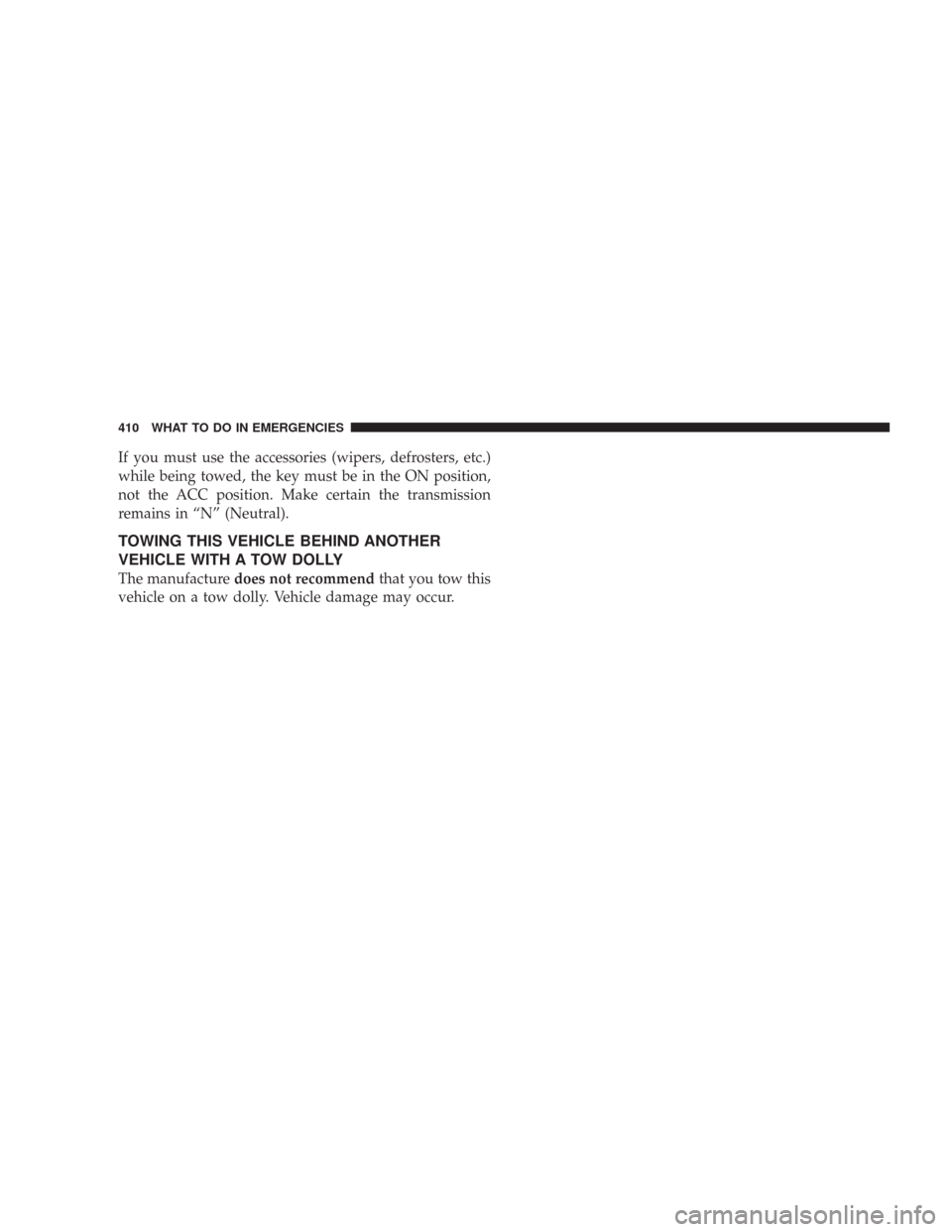
If you must use the accessories (wipers, defrosters, etc.)
while being towed, the key must be in the ON position,
not the ACC position. Make certain the transmission
remains in “N” (Neutral).
TOWING THIS VEHICLE BEHIND ANOTHER
VEHICLE WITH A TOW DOLLY
The manufacturedoes not recommendthat you tow this
vehicle on a tow dolly. Vehicle damage may occur.
410 WHAT TO DO IN EMERGENCIES
Page 412 of 520

MAINTAINING YOUR VEHICLE
CONTENTS
\12.7L Engine Compartment................414
\13.5L Engine Compartment................415
\15.7L Engine Compartment................416
\1Onboard Diagnostic System — OBD II........417
\3Loose Fuel Filler Cap..................417
\1Emissions Inspection And Maintenance
Programs............................418
\1Replacement Parts......................419
\1Dealer Service.........................420\1Maintenance Procedures..................420
\3Engine Oil..........................421
\3Engine Oil Filter......................425
\3Drive Belts — Check Condition And Tension . . 425
\3Spark Plugs.........................426
\3Engine Air Cleaner Filter................426
\3Fuel Filter..........................426
\3Catalytic Converter....................427
\3Maintenance-Free Battery................428
7
Page 413 of 520
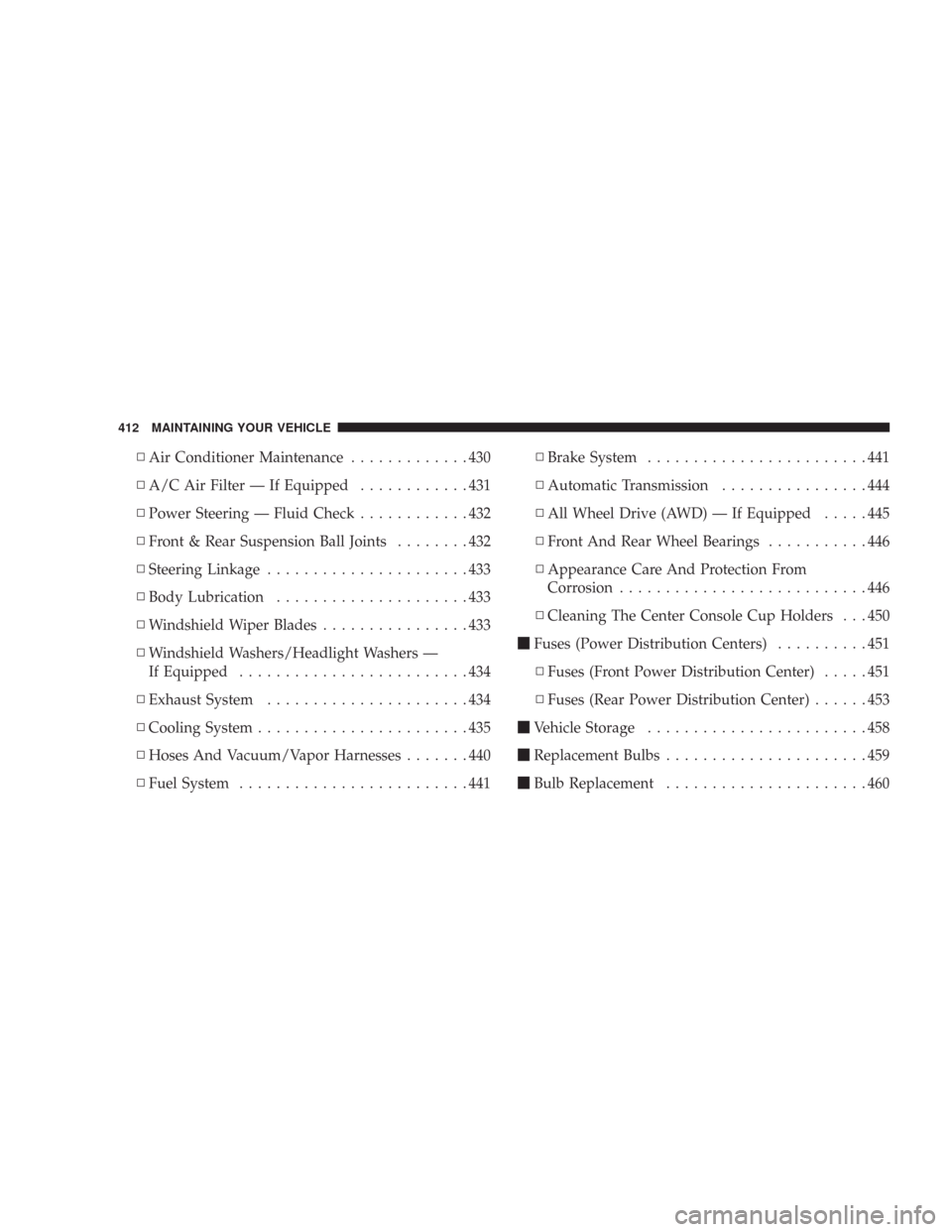
\3Air Conditioner Maintenance.............430
\3A/C Air Filter — If Equipped............431
\3Power Steering — Fluid Check............432
\3Front & Rear Suspension Ball Joints........432
\3Steering Linkage......................433
\3Body Lubrication.....................433
\3Windshield Wiper Blades................433
\3Windshield Washers/Headlight Washers —
If Equipped.........................434
\3Exhaust System......................434
\3Cooling System.......................435
\3Hoses And Vacuum/Vapor Harnesses.......440
\3Fuel System.........................441\3Brake System........................441
\3Automatic Transmission................444
\3All Wheel Drive (AWD) — If Equipped.....445
\3Front And Rear Wheel Bearings...........446
\3Appearance Care And Protection From
Corrosion...........................446
\3Cleaning The Center Console Cup Holders . . . 450
\1Fuses (Power Distribution Centers)..........451
\3Fuses (Front Power Distribution Center).....451
\3Fuses (Rear Power Distribution Center)......453
\1Vehicle Storage........................458
\1Replacement Bulbs......................459
\1Bulb Replacement......................460
412 MAINTAINING YOUR VEHICLE
Page 414 of 520

\3Low Beam Headlight, High Beam Headlight,
Park/Turn Light, Inner Park Light, And
Outer Park Light – 300 Models............460
\3Low Beam Headlight, High Beam Headlight,
And Park/Turn Light – 300C.............462
\3Backup Light, Side Marker Light, And Tail/
Stop Turn Light — 300 Models............465
\3Tail/Stop, Tail, Turn Signal Light, And Backup
Light — 300C Models..................468\3License Light........................472
\1Fluids And Capacities...................473
\1Fluids, Lubricants, And Genuine Parts........475
\3Engine.............................475
\3Chassis............................476
MAINTAINING YOUR VEHICLE 413
7
Page 415 of 520
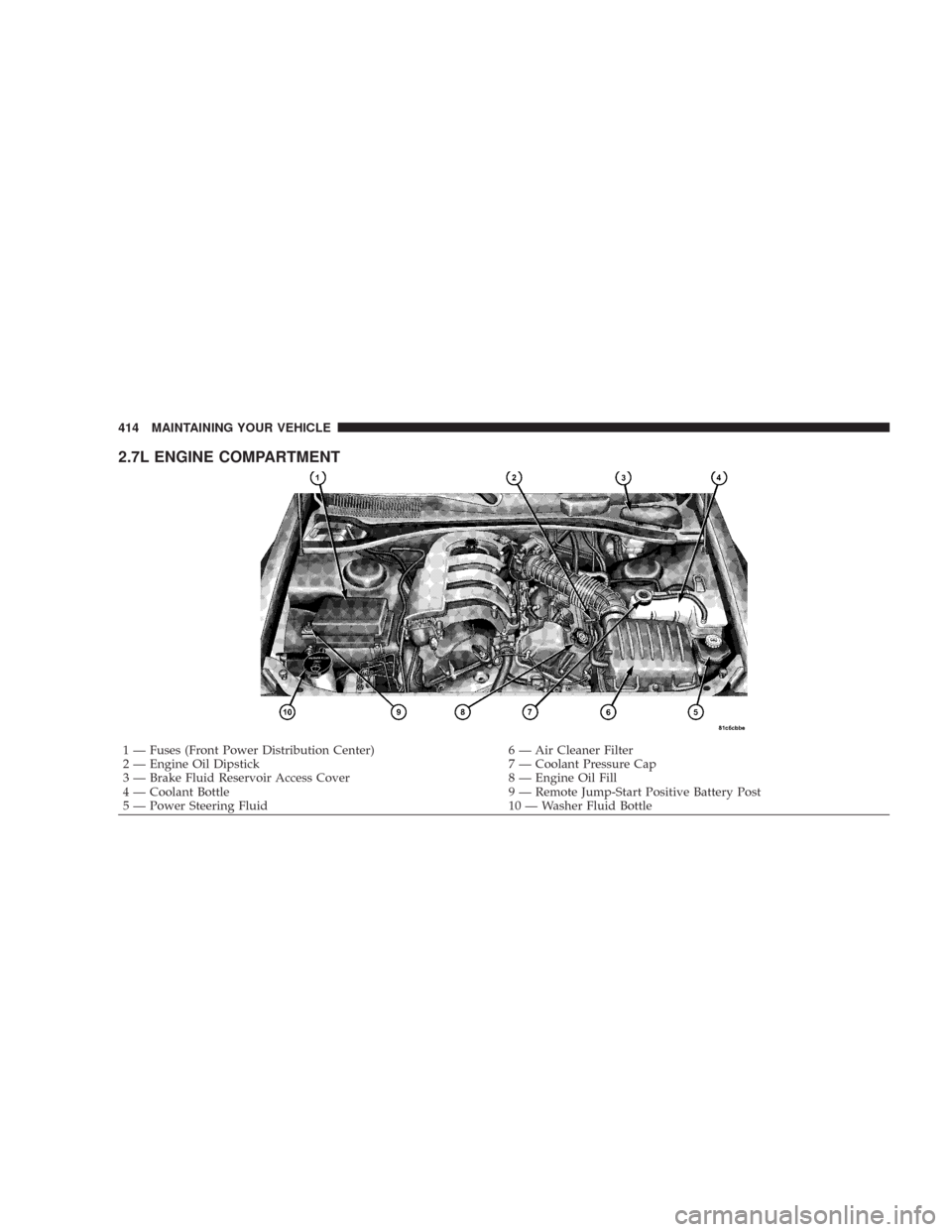
2.7L ENGINE COMPARTMENT
1 — Fuses (Front Power Distribution Center) 6 — Air Cleaner Filter
2 — Engine Oil Dipstick 7 — Coolant Pressure Cap
3 — Brake Fluid Reservoir Access Cover 8 — Engine Oil Fill
4 — Coolant Bottle 9 — Remote Jump-Start Positive Battery Post
5 — Power Steering Fluid 10 — Washer Fluid Bottle 414 MAINTAINING YOUR VEHICLE
Page 416 of 520
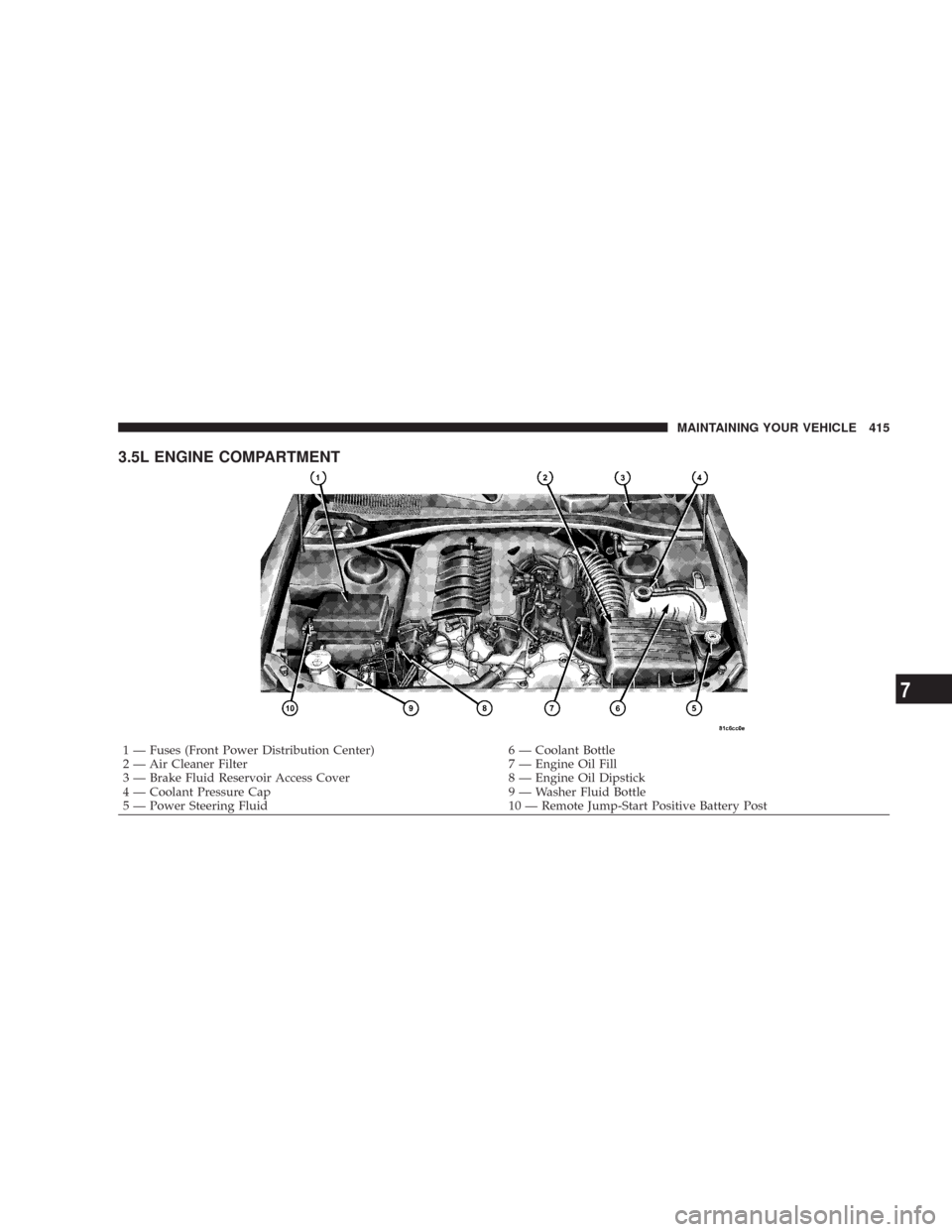
3.5L ENGINE COMPARTMENT
1 — Fuses (Front Power Distribution Center) 6 — Coolant Bottle
2 — Air Cleaner Filter 7 — Engine Oil Fill
3 — Brake Fluid Reservoir Access Cover 8 — Engine Oil Dipstick
4 — Coolant Pressure Cap 9 — Washer Fluid Bottle
5 — Power Steering Fluid 10 — Remote Jump-Start Positive Battery PostMAINTAINING YOUR VEHICLE 415
7
Page 417 of 520
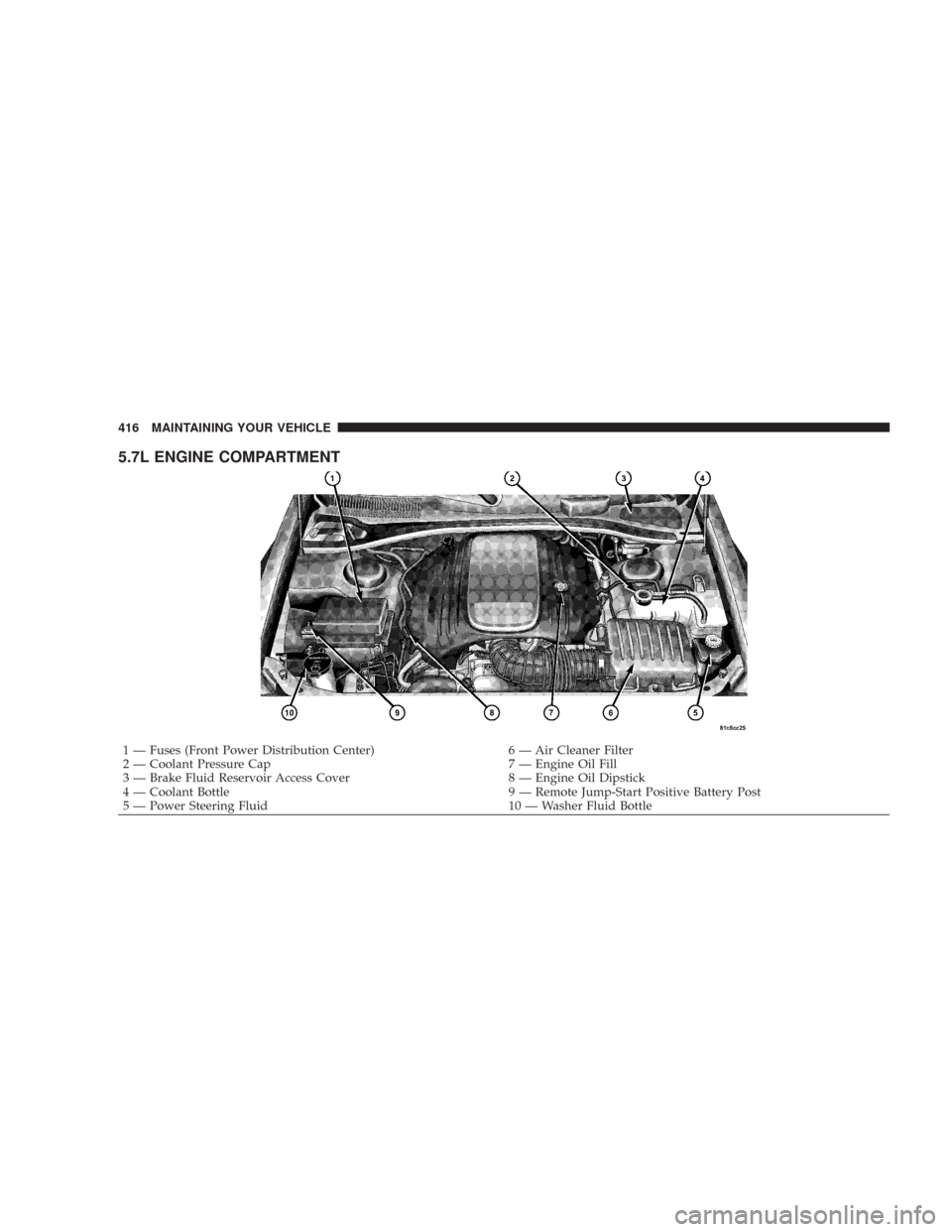
5.7L ENGINE COMPARTMENT
1 — Fuses (Front Power Distribution Center) 6 — Air Cleaner Filter
2 — Coolant Pressure Cap 7 — Engine Oil Fill
3 — Brake Fluid Reservoir Access Cover 8 — Engine Oil Dipstick
4 — Coolant Bottle 9 — Remote Jump-Start Positive Battery Post
5 — Power Steering Fluid 10 — Washer Fluid Bottle 416 MAINTAINING YOUR VEHICLE
Page 418 of 520

ONBOARD DIAGNOSTIC SYSTEM — OBD II
Your vehicle is equipped with a sophisticated onboard
diagnostic system called OBD II. This system monitors
the performance of the emissions, engine, and automatic
transmission control systems. When these systems are
operating properly, your vehicle will provide excellent
performance and fuel economy, as well as engine emis-
sions well within current government regulations.
If any of these systems require service, the OBD II system
will turn on the “Malfunction Indicator Light.” It will
also store diagnostic codes and other information to
assist your service technician in making repairs. Al-
though your vehicle will usually be drivable and not
need towing, see your dealer for service as soon as
possible.CAUTION!
Prolonged driving with the “Malfunction Indicator
Light” on could cause further damage to the emission
control system. It could also affect fuel economy and
driveability. The vehicle must be serviced before any
emissions tests can be performed.
If the “Malfunction Indicator Light” is flashing
while the engine is running, severe catalytic con-
verter damage and power loss will soon occur. Im-
mediate service is required.
Loose Fuel Filler Cap
If the vehicle diagnostic system determines that the fuel
filler cap is loose, improperly installed, or damaged, a
“Check Gascap” message will display in the Electronic
Vehicle Information Center (EVIC) — if equipped. If this
occurs, tighten the fuel filler cap properly and press the
MAINTAINING YOUR VEHICLE 417
7
Page 419 of 520

odometer reset button to turn off the message. If the
problem continues, the message will appear the next time
the vehicle is started.
A loose, improperly installed, or damaged fuel filler cap
may also turn on the Malfunction Indicator Light (MIL).
EMISSIONS INSPECTION AND MAINTENANCE
PROGRAMS
In some localities, it may be a legal requirement to pass
an inspection of your vehicle’s emissions control system.
Failure to pass could prevent vehicle registration.
For states, which have an I/M (Inspection and
Maintenance) requirement, this check verifies the
following: the MIL (Malfunction Indicator Light)
is functioning and is not on when the engine is running,
and that the OBD (On Board Diagnostic) system is ready
for testing.Normally, the OBD system will be ready. The OBD
system maynotbe ready if your vehicle was recently
serviced, if you recently had a dead battery, or a battery
replacement. If the OBD system should be determined
not ready for the I/M test, your vehicle may fail the test.
Your vehicle has a simple ignition key actuated test,
which you can use prior to going to the test station. To
check if your vehicle’s OBD system is ready, you must do
the following:
1. Insert your ignition key into the ignition switch.
2. Turn the ignition to the ON position, but do not crank
or start the engine.
3. If you crank or start the engine, you will have to start
this test over.
4. As soon as you turn your key to the ON position, you
will see your MIL symbol come on as part of a normal
bulb check.
418 MAINTAINING YOUR VEHICLE
Page 420 of 520

5. Approximately 15 seconds later, one of two things will
happen:
a. The MIL will flash for about 10 seconds and then
return to being fully illuminated until you turn off the
ignition key or start the engine. This means that your
vehicle’s OBD system isnot readyand you shouldnot
proceed to the I/M station.
b. The MIL will not flash at all and will remain fully
illuminated until you turn off the ignition key or start
the engine. This means that your vehicle’s OBD system
isreadyand you can proceed to the I/M station.
If your OBD system isnot ready,you should see your
authorized dealer or repair facility. If your vehicle was
recently serviced or had a battery failure or replacement,
you may need to do nothing more than drive your
vehicle as you normally would in order for your OBD
system to update. A recheck with the above test routine
may then indicate that the system is now ready.Regardless of whether your vehicle’s OBD system is
ready or not ready, if the MIL symbol is illuminated
during normal vehicle operation, you should have your
vehicle serviced before going to the I/M station. The I/M
station can fail your vehicle because the MIL symbol is on
with the engine running.
REPLACEMENT PARTS
Use of genuine Mopar\2parts for normal/scheduled
maintenance and repairs is highly recommended to in-
sure the designed performance. Damage or failures
caused by the use of non-Mopar\2parts for maintenance
and repairs will not be covered by the manufacturer’s
warranty.
MAINTAINING YOUR VEHICLE 419
7